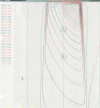Beam-commissioning methodology for a three-dimensional convolution/superposition photon dose algorithm
- PMID: 11674815
- PMCID: PMC5726162
- DOI: 10.1120/jacmp.v1i1.2651
Beam-commissioning methodology for a three-dimensional convolution/superposition photon dose algorithm
Abstract
Commissioning beam data for the convolution/superposition dose-calculation algorithm used in a commercial three-dimensional radiation treatment planning (3D RTP) system (PINNACLE(3), ADAC Laboratories, Milpitas, CA) can be difficult and time consuming. Sixteen adjustable parameters, as well as spectral weights representing a discrete energy spectrum, must be fit to sets of central-axis depth doses and off-axis profiles for a large number of field sizes. This paper presents the beam-commissioning methodology that we used to generate accurate beam models. The methodology is relatively rapid and provides physically reasonable values for beam parameters. The methodology was initiated by using vendor-provided automodeling software to generate a single set of beam parameters that gives an approximate fit to relative dose distributions for all beams, open and wedged, in a data set. A limited number of beam parameters were adjusted by small amounts to give accurate beam models for four open-beam field sizes and three wedged-beam field sizes. Beam parameters for other field sizes were interpolated and validated against measured beam data. Using this methodology, a complete set of beam parameters for a single energy can be generated and validated in approximately 40 h. The resulting parameter values yielded calculated relative doses that matched measured relative doses in a water phantom to within 0.5-1.0% along the central axis and 2% along off-axis beam profiles for field sizes from 4 cmx4 cm to the largest field size available. While the methodology presented is specific to the ADAC PINNACLE(3) treatment planning system, the approach should apply to other implementations of the dose model in other treatment planning system.
Figures



References
-
- Fraass B., Doppke K., Hunt M., Kutcher G., Starkschall G., Stern R., and Van Dyk J., “American Association of Physicists in Medicine Radiation Therapy Committee Task Group 53: Quality assurance for clinical radiotherapy treatment planning,” Med. Phys. 25, 1773–1829 (1998). - PubMed
-
- Mackie T. R., Reckwerdt P., McNutt T., Gehring M., and Sanders C., in Teletherapy: Present and Future, edited by Mackie T. R. and Palta J. R. (Advanced Medical Publishing, Madison, WI, 1996), pp. 103–135.
-
- Mackie T. R., Liu H. H., and McCullough E. C., in Treatment Planning in Radiation Oncology, edited by Khan F. M. and Potish R. A. (Williams & Wilkins, Baltimore, 1998), pp. 90–112.
-
- Starkschall G. and Hogstrom K. R., in A Practical Guide to 3‐D Planning and Conformal Radiation Therapy, edited by Purdy J. A. and Starkschall G. (Advanced Medical Publishing, Madison, WI, 1999), pp. 107–122.
-
- Suntharalingam N. and Sweet J. W., “Experience with CMS‐FOCUS 3D RTP system,” presented at the Annual meeting of the American College of Medical Physics, Lake Tahoe, NV, 1997. (unpublished).
MeSH terms
LinkOut - more resources
Full Text Sources
Other Literature Sources

